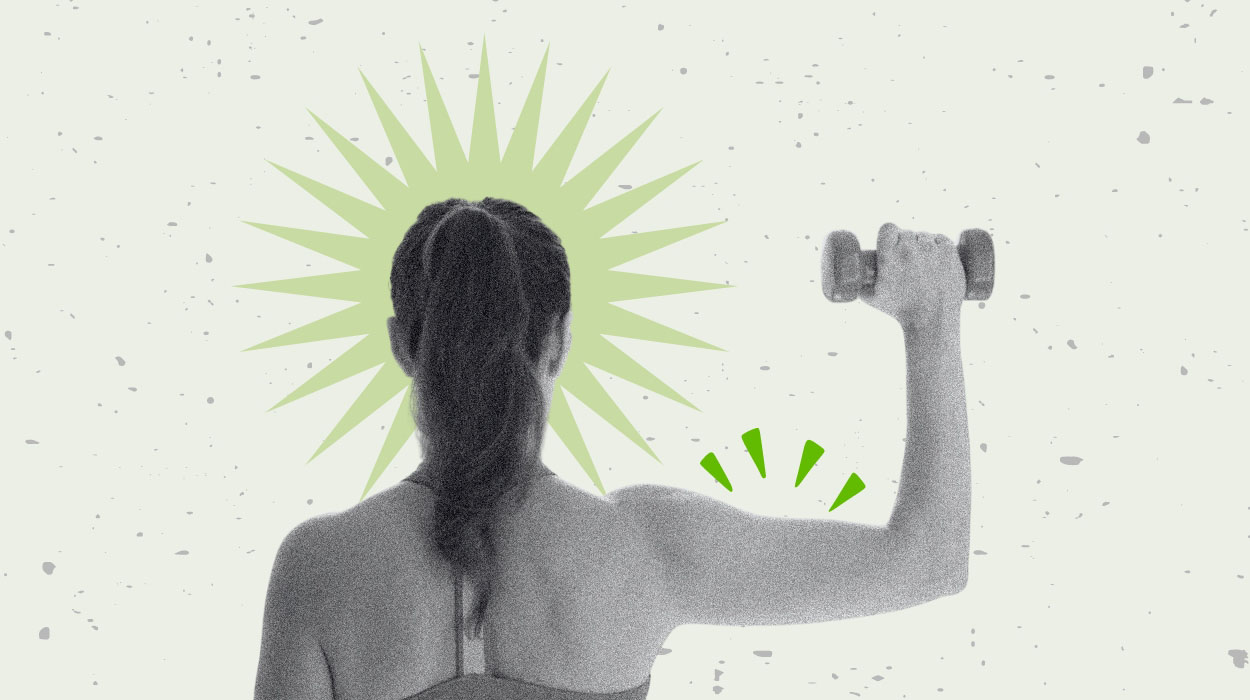
Many women only train their lower body and don’t want to strength train their upper body for fear of becoming too big or manly, but still want the appearance of toned muscles. Truth is, ladies, toned muscles are strong muscles, and strong muscles are built with weights. Bottom line: Don’t skip upper body workout for women!
To build upper body strength, it is essential to do regular resistance training. By using the principle of progressive overload (gradually increasing the intensity of your workout), you can gain strength and begin to see more tone throughout your upper body.
Female Upper Body Workout
Training upper body muscles is important for muscular definition and for other health reasons listed below. Here are the exercises we will cover in more detail:
Upper Body Workout For Women
There are many workouts in the books, but we’ve narrowed it down for you and will go over in detail some of the best upper body exercises for women. Listed first are exercises you can do without equipment, followed by exercises that require machines, free weights, or resistance bands.
Without Equipment
Pause Push-Ups
Start in a plank position with your hands on the ground shoulder-width apart. Inhale and slowly lower your body until you’re just hovering above the floor and hold for one second. Exhale as you push back to the start position.
If full-body weight push-ups are too difficult, you can do modified push-ups by putting your hands on a bench or couch, feet still on the floor. Perform three sets of 10-12 repetitions. This will challenge your core muscles and strengthen your shoulders and chest.
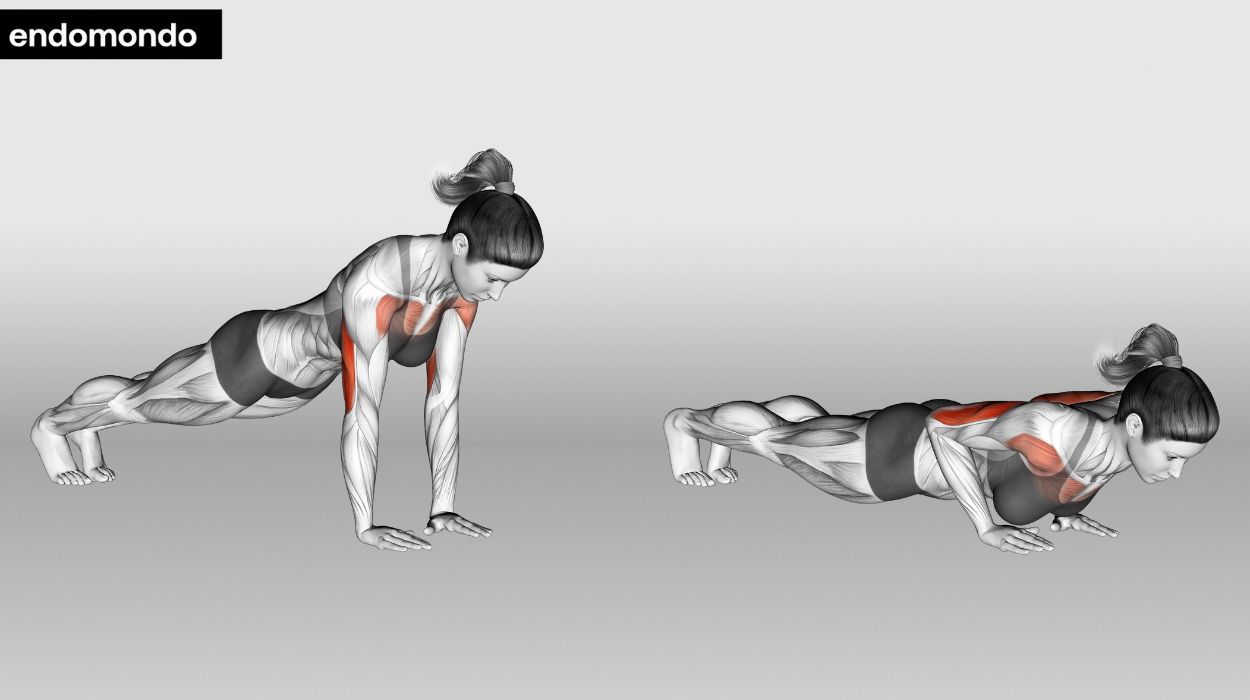
How to do:
- Begin in a plank position, hands shoulder-width apart on the ground.
- Inhale and slowly lower your body, hovering just above the floor.
- Hold for one second near the floor.
- Exhale and push back to the starting position.
Tips:
- Keep your body in a straight line from head to heels, engaging your core to avoid sagging or arching.
- Lower yourself slowly and hold just above the ground to maximize muscle engagement and improve strength.
- Coordinate your breathing with your movements – inhale on the way down, pause, then exhale on the push-up.
Optimal Sets and Reps: Perform 3 to 4 sets of 6 to 8 reps each.
Wall Angels
Wall Angels are an effective exercise for improving posture and upper back strength. Performed standing against a wall with arms in a goalpost position, the movement involves smoothly sliding arms up and down, mimicking an angel’s wings. This exercise engages shoulder and upper back muscles, enhancing mobility and stability.

How to do:
- Stand with back against a wall, arms in field goal position.
- Raise arms until hands touch above head, keeping arms against the wall.
- Maintain a slight bend in your elbows throughout.
- Lower arms back to the starting position.
Tips:
- Ensure your head, upper back, and hips stay in contact with the wall throughout the exercise for proper alignment.
- Move your arms slowly and smoothly, keeping them as close to the wall as possible to fully engage the targeted muscles.
- Keep your core engaged and avoid arching your lower back to enhance posture correction benefits.
Optimal Sets and Reps: Aim for 3 sets of 10-15 reps each.
Mountain Climbers
Mountain Climbers is a dynamic, full-body exercise that combines cardiovascular and strength training. Starting in a plank position, it involves rapidly alternating knees towards the chest, simulating a climbing motion. This exercise effectively targets the core, arms, and legs, while also boosting heart rate, making it excellent for both muscle toning and aerobic conditioning.
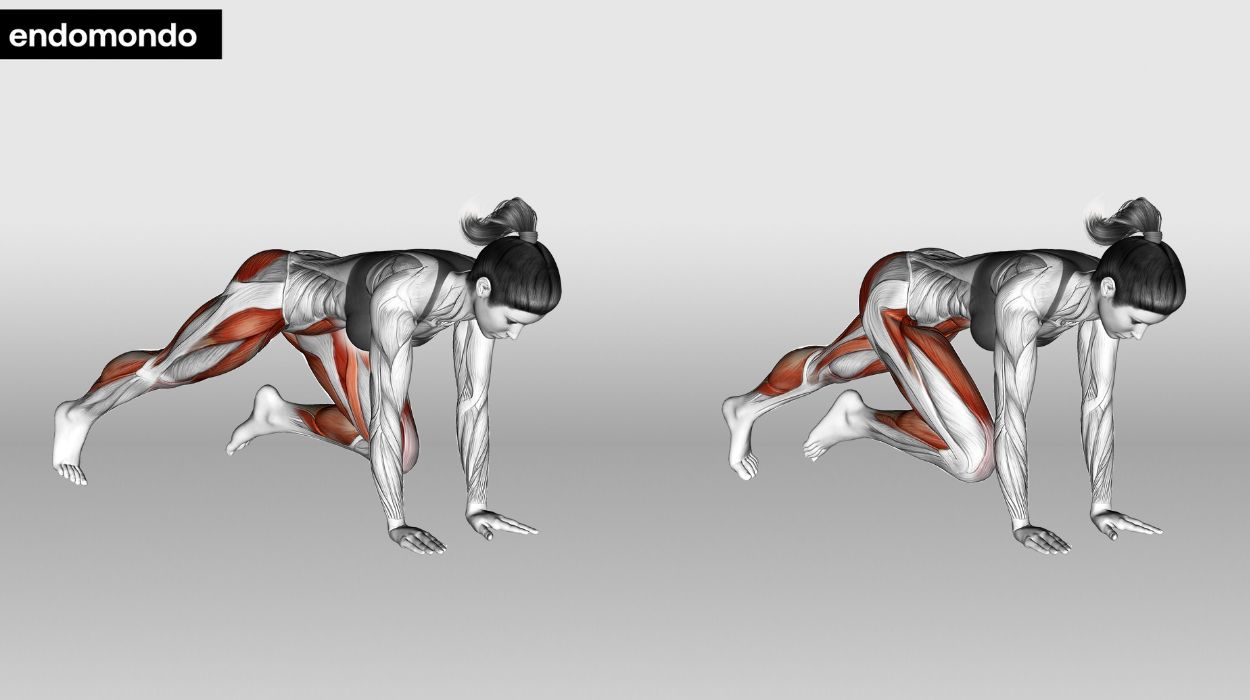
How to do:
- Begin in a plank position.
- Slightly lift one foot and bring that knee to touch the same-side elbow.
- Return the leg to the starting plank position.
- Alternate legs, repeating the motion.
Tips:
- Keep your abdominals engaged and back flat throughout the exercise to maximize core activation and maintain stability.
- Move your legs in a controlled, deliberate manner, rather than simply focusing on speed, to effectively work the targeted muscles.
- Ensure your shoulders are directly above your hands to maintain proper form and reduce the risk of shoulder strain.
Optimal Sets and Reps: Aim for 3 sets of 20-30 repetitions (10-15 per leg).
Dips
Dips are a powerful upper-body exercise focusing on the triceps, chest, and shoulders. Performed using parallel bars or a stable surface, the movement involves lowering the body by bending the elbows and then pushing back up to the starting position. Dips effectively build upper body strength workout women and muscle definition.
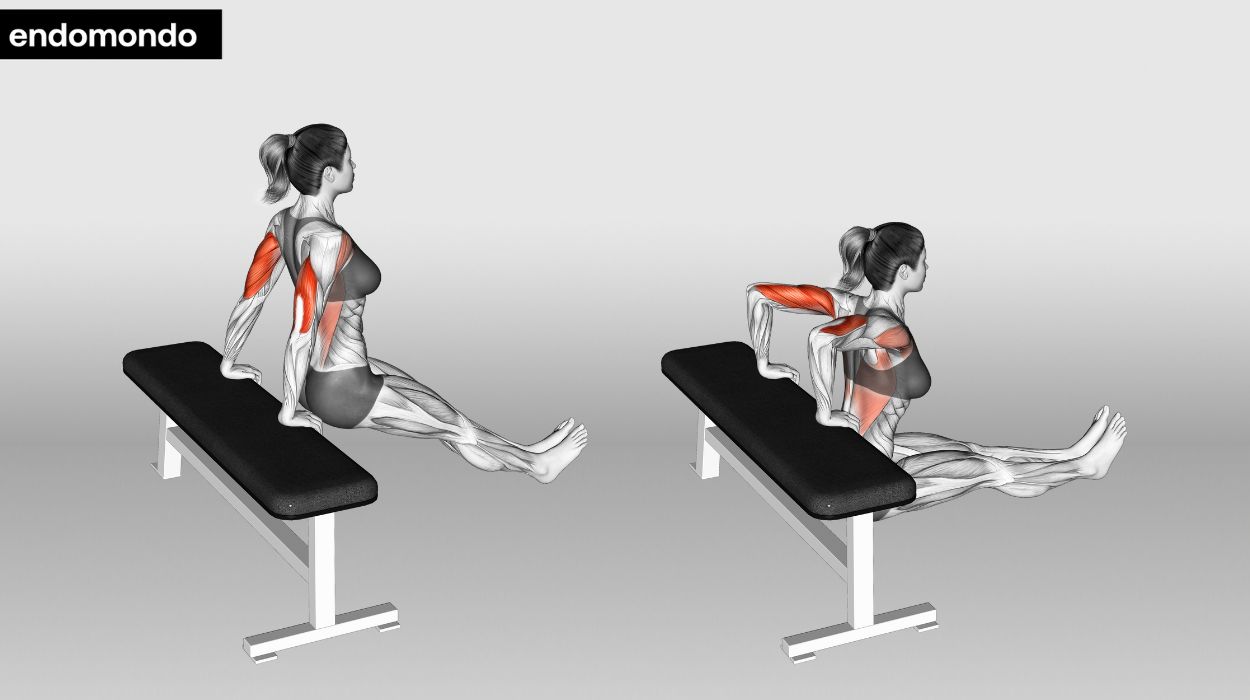
How to do:
- Sit on the edge of a bench or couch, legs extended.
- Place hands beside hips on the bench.
- Push up, moving your bottom in front of the bench.
- Bend your elbows, lowering your bottom toward the floor.
- Push up to straighten elbows, and body in front of the bench.
Tips:
- Keep your elbows pointed straight back, not flaring out, to focus the workout on your triceps.
- Lower your body slowly and smoothly, then push up with control to avoid straining your shoulders.
- Lean slightly forward during the dip to engage more of your chest muscles, while keeping your body close to the bench.
Optimal Sets and Reps: Aim for 3 sets of eight to 12 reps each.
Reverse Plank
The Reverse Plank is a core-strengthening exercise emphasizing the posterior muscles of the body. Performed by sitting with legs extended, hands under shoulders, and lifting the hips to create a straight line from head to heels, it engages the core, glutes, shoulders, and upper back, enhancing posture and stability.
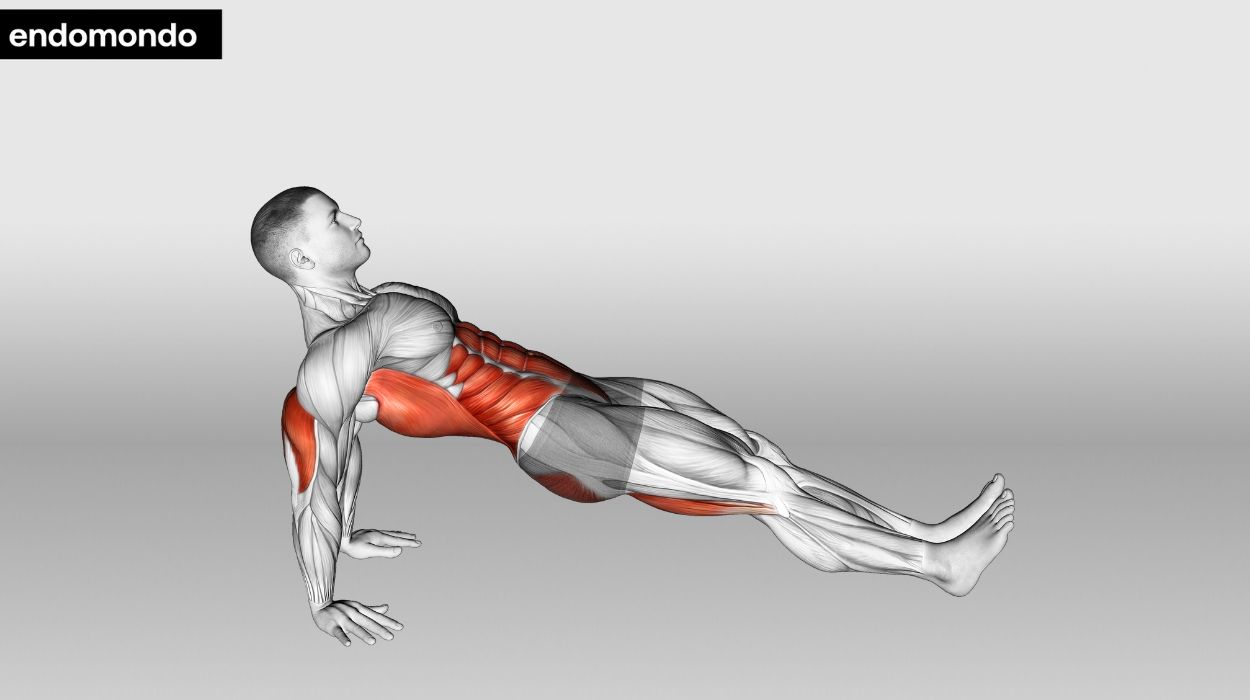
How to do:
- Sit on the ground, legs straight, feet hip-distance apart.
- Place hands directly under shoulders on the ground.
- Lift your bottom to form a straight line from feet to head.
- Keep hands under your shoulders, and maintain a straight posture.
- Engage the core and hold the position for about twenty seconds.
Tips:
- Place your hands firmly under your shoulders with fingers spread for stability and to reduce wrist strain.
- Actively tighten your core and squeeze your glutes to maintain a straight body line and enhance the effectiveness of the exercise.
- Keep your body in a straight line from your head to your heels, avoiding sagging or lifting your hips too high.
Optimal Sets and Reps: Hold 20-30 seconds per set.
With Equipment
Dumbbell Bench Presses
The Dumbbell Bench Press is a fundamental upper-body exercise that targets the chest, triceps, and shoulders. Performed lying on a bench, involves pressing dumbbells upwards from chest level and then lowering them back down, allowing for a wide range of motion and balanced muscle development on both sides. This will hit your chest, shoulders, and triceps.
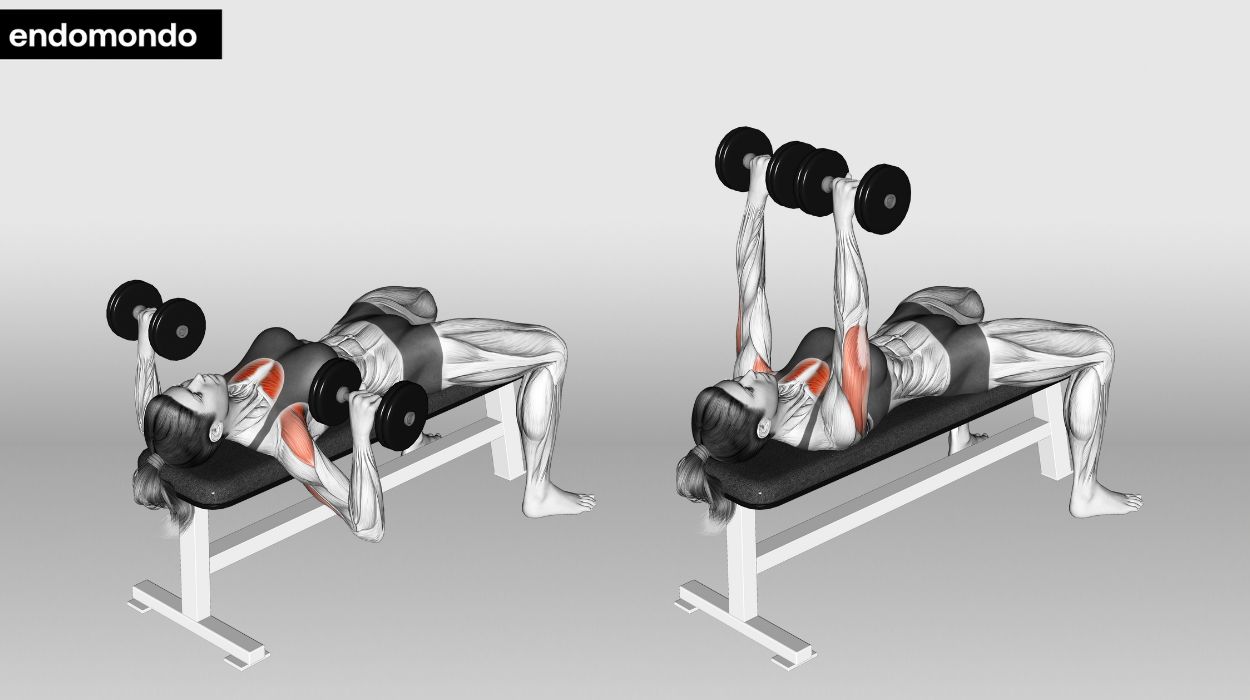
How to do:
- Sit on a bench, dumbbells in hands resting on knees.
- Lie back, bringing weights near your shoulders, elbows bent behind you.
- Start with weights close to shoulder joints.
- Push weights up toward the ceiling, straightening arms.
- Ensure weights are above your shoulders at the top.
- Use heavier weights for this compound exercise.
Tips:
- Keep your wrists straight and align the dumbbells with your chest, not your shoulders, to maximize chest engagement and reduce the risk of injury.
- Lower the dumbbells slowly to your chest and press up powerfully, ensuring a controlled motion throughout the exercise for better muscle activation.
- Plant your feet firmly on the ground and maintain a slight arch in your lower back to stabilize your body and generate more power.
Optimal Sets and Reps: Aim for 4 sets of 6 to 8 reps each.
Lat Pull Down Machine
The Lat Pull Down Machine is a staple piece of equipment in strength training, primarily targeting the latissimus dorsi muscles in the back. It consists of a cable pulley and a weighted stack, allowing users to perform pull-down exercises from a seated position, thereby enhancing upper body strength and improving back muscle definition.

How to do:
- Sit at the machine and grasp the bar with an overhand grip.
- Pull the bar down to your chest.
- Slowly return to the starting position with control.
- Use a heavy weight for maximum effectiveness.
Tips:
- Grip the bar slightly wider than shoulder-width, and sit with a straight back, avoiding leaning back excessively.
- Pull the bar smoothly towards your chest, focusing on squeezing your shoulder blades together, then release slowly back to the start.
- Use your lats to pull the weight, not momentum, by avoiding jerky movements or swinging.
Optimal Sets and Reps: Perform 3 or 4 sets of 6 to 8 reps each.
Dumbbell Rows
Dumbbell Rows are a versatile upper-body exercise focusing on the back muscles, particularly the latissimus dorsi. Performed typically with one knee and hand on a bench for support, this exercise involves lifting a dumbbell with the opposite hand in a rowing motion, enhancing back strength and improving muscular symmetry.
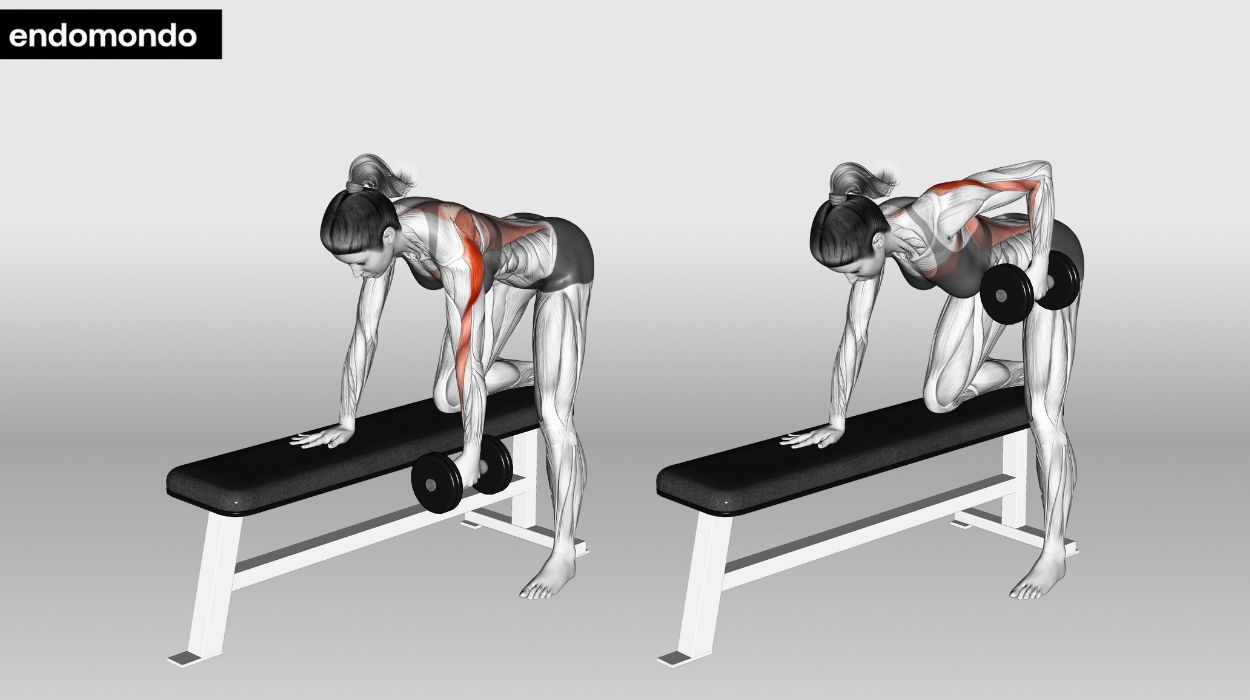
How to do:
- Position as a single-arm row with left hand and knee on a bench.
- Face the ground, right foot on the floor, a dumbbell in the right hand.
- Let the right arm hang towards the floor, holding the dumbbell.
- Pull weight towards your body, aligning the upper right arm with the torso.
- Keep the core engaged for a neutral spine.
- Use a heavy weight for effectiveness.
Tips:
- Ensure your back is straight and parallel to the ground, avoiding any arching or rounding.
- Keep your core muscles tight throughout the movement to stabilize your body and protect your spine.
- Lift the dumbbell smoothly towards your torso and lower it back down with control, focusing on using your back muscles rather than momentum.
Optimal Sets and Reps: Aim for 3 to 4 sets of 6 to 8 reps each.
Band Pull-Aparts
Band Pull-Aparts are a simple yet effective upper-body exercise that utilizes a resistance band. Primarily targeting the shoulders, upper back, and rear deltoids, this exercise involves holding the band in front and pulling it apart horizontally, enhancing shoulder stability and posture while strengthening the upper back muscles.
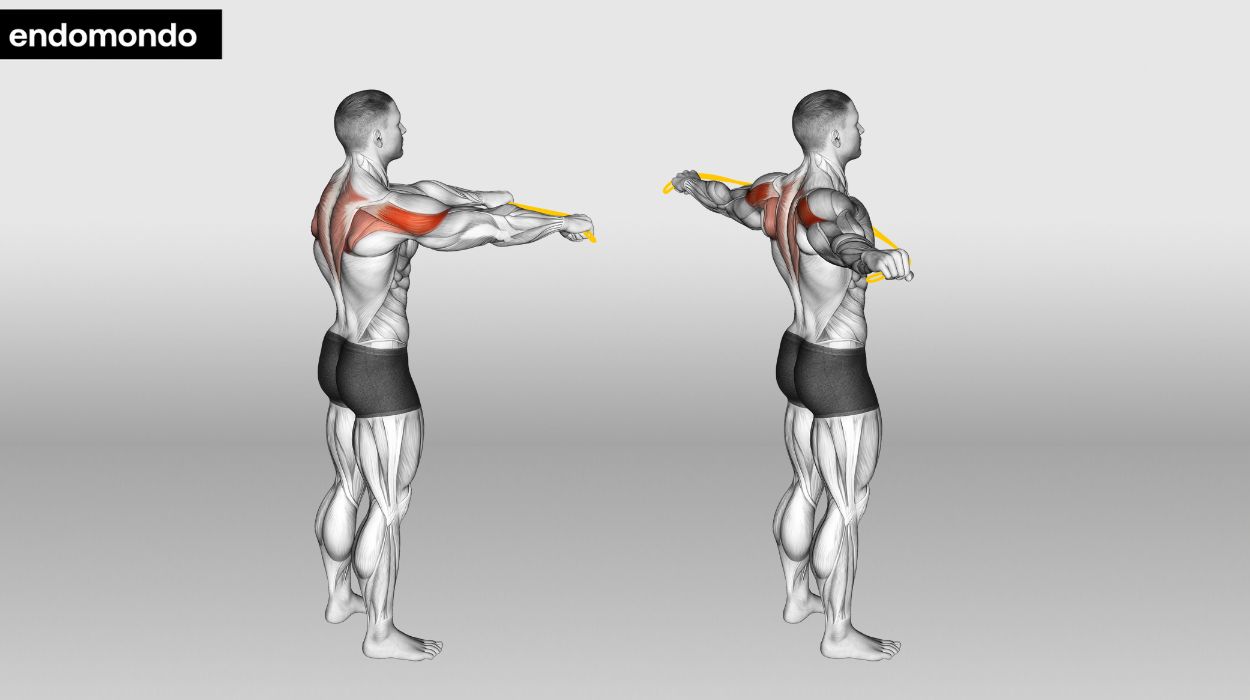
How to do:
- Use a large loop resistance band, light to medium resistance.
- Stand or sit for the exercise.
- Hold the band straight in front, palms facing down.
- Pull the band at shoulder height until it touches your chest.
- Arms reach out to the side, squeezing shoulder blades.
- Slowly return to the starting position.
Tips:
- Keep the band taut throughout the exercise to ensure consistent resistance and effective muscle engagement.
- Pull the band apart slowly and with control, focusing on squeezing your shoulder blades together at the end of the movement.
- Keep your arms parallel to the floor at shoulder height to target the correct muscles and maintain proper form.
Optimal Sets and Reps: Aim for 3 sets of 10 to 12 reps each.
Bicep Curls
Bicep Curls are a fundamental strength training exercise primarily targeting the biceps. Performed with dumbbells, barbells, or resistance bands, the exercise involves curling the weight upwards by bending the elbow while keeping the upper arm stationary. It’s effective for building arm strength, enhancing muscle tone, and improving overall arm aesthetics.
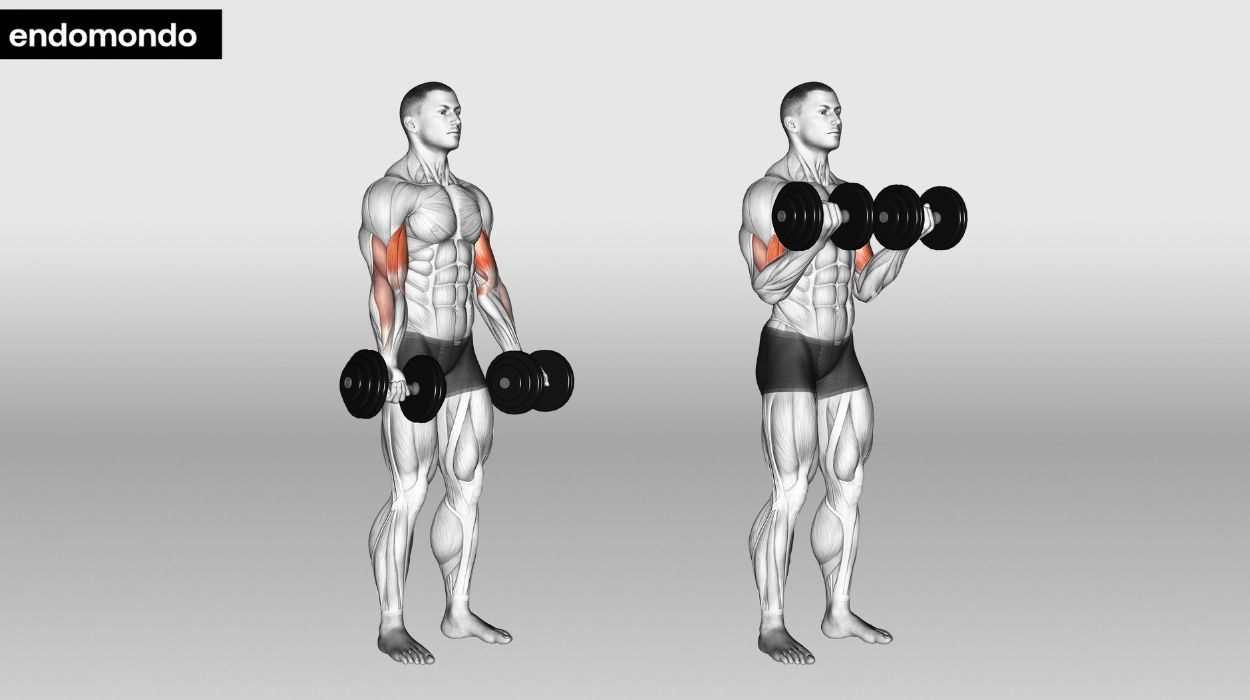
How to do:
- Stand with a dumbbell in each hand, palms facing forward.
- Arms at your sides, upper arms in contact with your trunk.
- Bend at the elbows, lifting weights towards your shoulders.
- Slowly lower the weights back to the starting position.
- Use lighter weights as it’s an isolation exercise.
Tips:
- Stand with your feet shoulder-width apart and maintain a straight posture, avoiding swinging your body for momentum.
- Curl the weights with controlled motion, focusing on squeezing the biceps at the top, then lowering them slowly to maximize muscle engagement.
- Keep your elbows close to your sides and avoid moving them forward to ensure the biceps are fully worked.
Optimal Sets and Reps: Perform 3 to 4 sets of 10 to 12 reps each.
Tricep Extensions
Tricep Extensions are a focused exercise primarily targeting the triceps, the muscles at the back of the upper arms. Typically performed with dumbbells, barbells, or cable machines, the exercise involves extending the arms to lift the weight overhead, then lowering it back, effectively strengthening and toning the triceps.
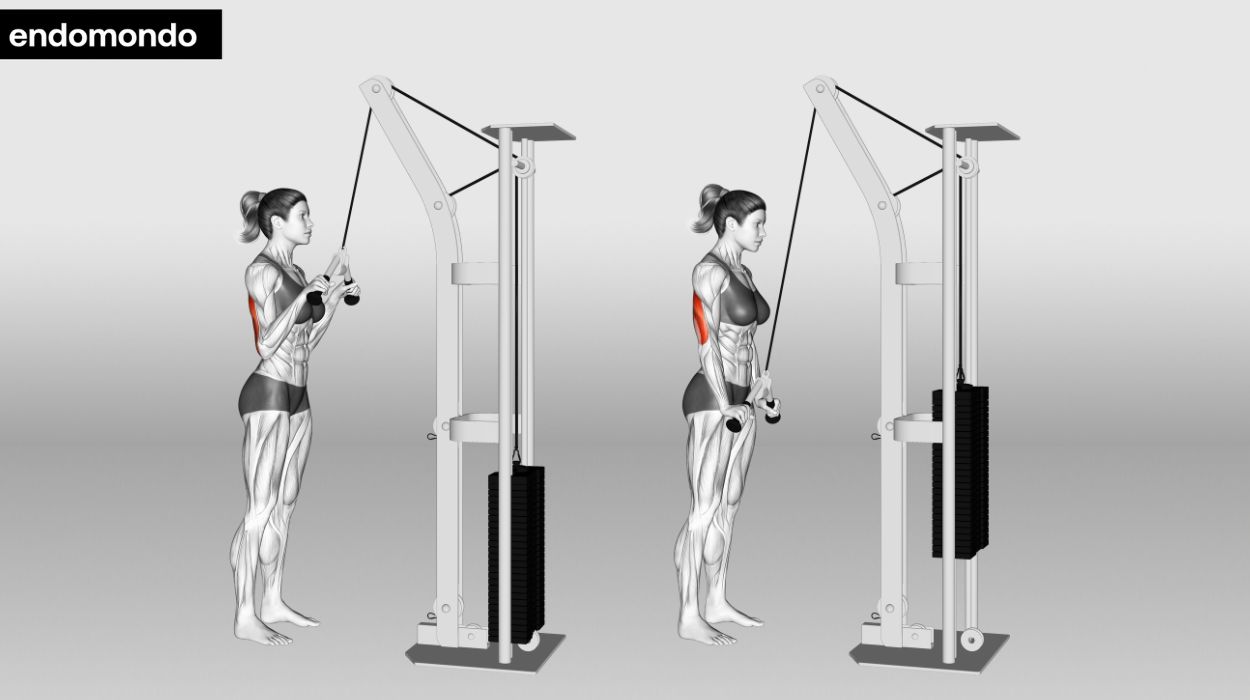
How to do:
- Stand facing a cable machine, set at head height.
- Feet hip-width apart for stability.
- Use a straight bar or rope attachment.
- Keep your upper arms in contact with your trunk.
- Push the cable down towards the hips, straightening elbows.
Tips:
- Keep your elbows close to your head and pointed forward to isolate the triceps effectively.
- Extend your arms slowly and smoothly, then lower the weight back with equal control to maximize triceps engagement.
- Engage your core and maintain a straight posture throughout the exercise to support your upper body and enhance stability.
Optimal Sets and Reps: Aim for 3 to 4 sets of 10-12 reps each.
Lateral Raises
Lateral Raises are a fundamental exercise for shoulder development, specifically targeting the deltoid muscles. Performed standing with a dumbbell in each hand, the movement involves lifting the arms out to the sides, up to shoulder level, and then lowering them back down, effectively enhancing shoulder strength and definition.
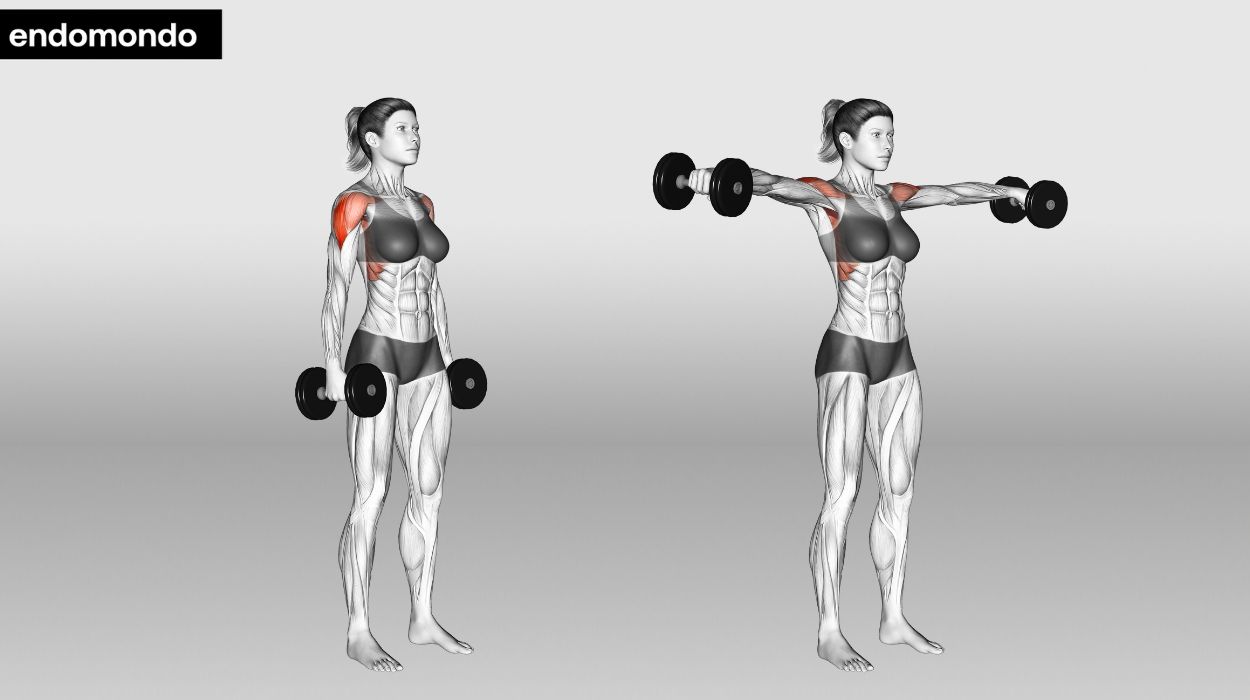
How to do:
- Stand with arms at sides, dumbbell in each hand.
- Slightly bend your knees for stability.
- Keep arms straight, and lift to the sides to shoulder level.
- Slowly lower arms back to sides.
Tips:
- Raise and lower the dumbbells smoothly, avoiding any jerky movements or swinging to ensure the deltoids are effectively targeted.
- Keep a slight bend in your elbows throughout the exercise to reduce strain on your joints.
- Engage your core and keep your back straight to prevent swaying, ensuring the focus remains on the shoulder muscles.
Optimal Sets and Reps: Aim for 3 to 4 sets of 10-12 reps each.
Overhead Press Machine
The Overhead Press Machine is a strength-building exercise targeting the shoulder muscles, particularly the deltoids. Users sit with their backs against a pad, pressing handles or a barbell overhead in a controlled motion. This machine offers stability and focused resistance, making it effective for enhancing shoulder strength and muscle definition.
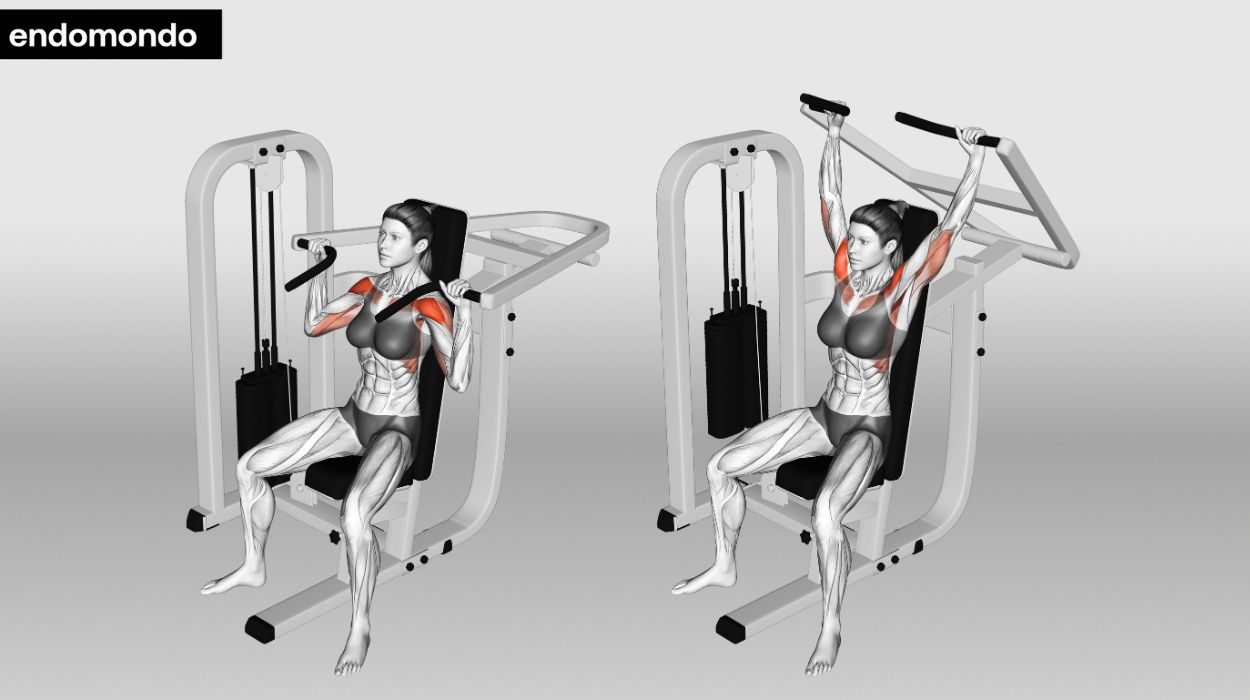
How to do:
- Sit with your back against the pad of the shoulder press machine.
- Grab the handles and press straight up to full extension.
- Avoid shrugging shoulders at the top to prevent neck pain.
- Slowly lower back to the starting position.
Tips:
- Sit with your back firmly against the pad, aligning your head and spine to reduce strain.
- Press up to full extension without locking your elbows at the top to maintain tension on your shoulders and prevent joint strain.
- Lift and lower the weight smoothly, focusing on engaging the shoulder muscles rather than relying on momentum.
Optimal Sets and Reps: Aim for 3 to 4 sets of 6 to 8 reps each.
Benefits Of Upper Body Workout Female

Strength training has been gaining popularity in recent years and for many good reasons. Studies have shown[1] that resistance training helps promote positive body image. It eases physique anxiety and improves body composition satisfaction.
Lifting weights has also been shown to improve bone density[2] which reduces the risk of osteoporosis. Osteoporosis is a condition where the bones become weaker, thus more susceptible to fractures, and is more common in women.
Building strength can help improve posture[3] by making your postural muscles more resilient and giving them more endurance. This can then decrease the chance of developing low back pain.
With your strong upper body, you’ll start to notice that everyday tasks become easier. You’ll be able to more easily move heavy objects like furniture, carry heavier bags, and reach things on high shelves with less risk of injury. The last benefit we’ll list here (knowing there are more out there!) is that strength training has positive effects on people with certain heart conditions.[4]
Tips For Upper Body Workout Women
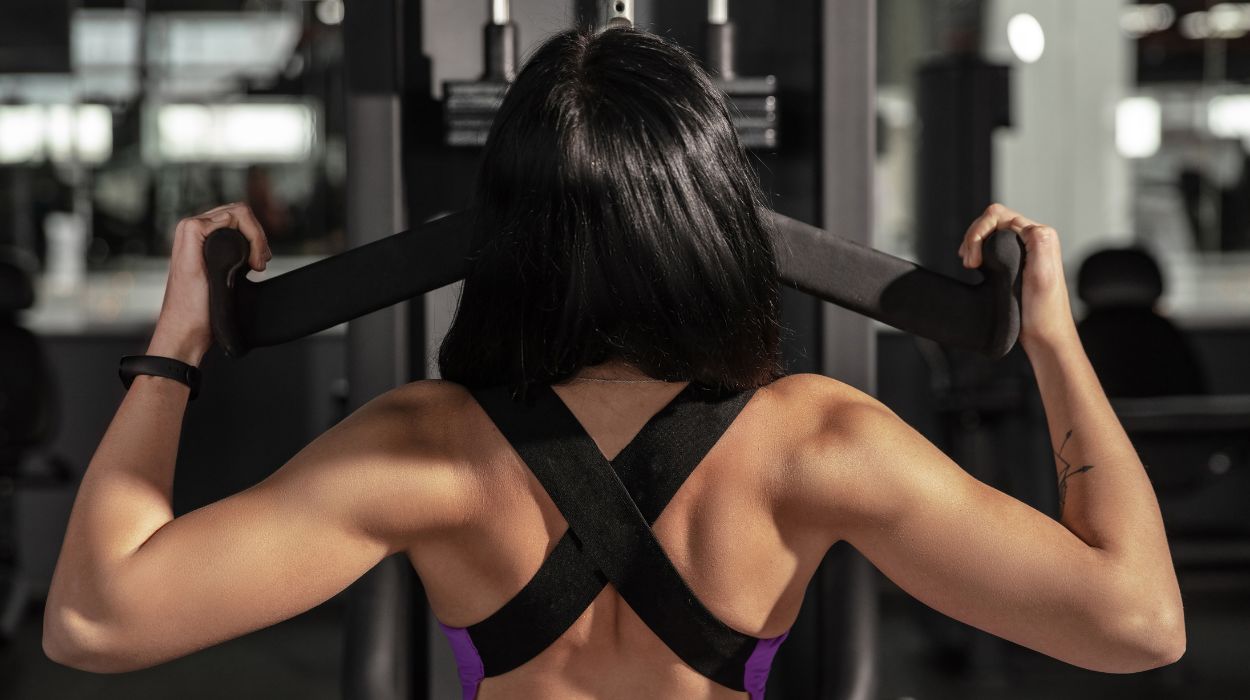
An essential component of an effective workout routine is nutrition. Whether your goal is to lose weight, get toned arms and a flat stomach, or improve self-esteem, being insistent on getting enough protein will help you see results faster. Here are some ideas for a healthy breakfast to get you started!
You’ll need to stay motivated to go to the gym to see results. Try finding a workout buddy to keep you accountable, and safe, and to push you during your upper body workouts. Another way to stay motivated is to track your workouts in a notebook or note on your phone. If you stick to the same routine, write down how much weight and how many sets and reps you do for each exercise so you can see progress over time.
Lastly, give yourself grace! Typically, it will take at least six weeks[5] to notice changes in your body, such as muscle definition or loss of body fat. Stay consistent and try to do your upper body workout at least twice per week.
Conclusion
It’s time to embrace an upper-body strength workout. Add these exercises to your fitness routine to make your upper body strong, get toned arms, and create a more positive body image. Take a deep breath, you’ve got this!
Frequently Asked Questions
A compound exercise is where multiple joints are involved. For example, a lat pulldown or bench press involves the shoulders and elbows. An isolation lift is where only one joint is moving like a lateral raise (shoulders) bicep curl or tricep pushdown (elbows).
To ensure safety with form, seek help from a certified personal trainer or a physical therapist.
The best workout is the one that you stick to! Consistency is key. Find a gym you feel comfortable at and a routine that fits your schedule.
Resources
- SantaBarbara, N.J., Whitworth, J.W. and Ciccolo, J.T. (2017). A Systematic Review of the Effects of Resistance Training on Body Image. The Journal of Strength and Conditioning Research, [online] 31(10), pp.2880–2888. doi:https://doi.org/10.1519/jsc.0000000000002135.
- A Ram Hong and Sang Wan Kim (2018). Effects of Resistance Exercise on Bone Health. Endocrinology and Metabolism, [online] 33(4), pp.435–435. doi:https://doi.org/10.3803/enm.2018.33.4.435.
- Su Su Hlaing, Rungthip Puntumetakul, Ei Ei Khine and Boucaut, R. (2021). Effects of core stabilization exercise and strengthening exercise on proprioception, balance, muscle thickness and pain related outcomes in patients with subacute nonspecific low back pain: a randomized controlled trial. BMC Musculoskeletal Disorders, [online] 22(1). doi:https://doi.org/10.1186/s12891-021-04858-6.
- Fisher, S.G., Smart, N.A. and Pearson, M.J. (2021). Resistance training in heart failure patients: a systematic review and meta-analysis. Heart Failure Reviews, [online] 27(5), pp.1665–1682. doi:https://doi.org/10.1007/s10741-021-10169-8.
- Damas, F., Cleiton Augusto Libardi and Ugrinowitsch, C. (2017). The development of skeletal muscle hypertrophy through resistance training: the role of muscle damage and muscle protein synthesis. European Journal of Applied Physiology, [online] 118(3), pp.485–500. doi:https://doi.org/10.1007/s00421-017-3792-9.




